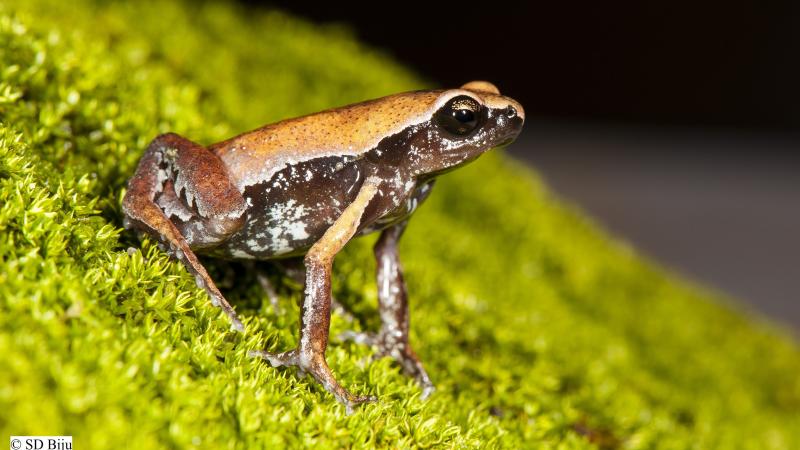
The forests of the Western Ghats, a biodiversity hotspot of India, have been revealing several new species of amphibians and reptiles in the recent years. This time, however, amphibian researchers from the University of Delhi have discovered a new frog species which was hiding in plain sight in a roadside puddle in Southern India. They have detailed their discovery, which was funded in part by grants from Critical Ecosystem Partnership Fund; Department of Science and Technology, Government of India; and University of Delhi, in the journal Scientific Reports.
This new species belongs to the family of narrow-mouthed frogs (Microhylidae) and was found to be under an entirely new genus, called Mysticellus. The genus was named after the Latin word mysticus meaning ‘mysterious’, owing to their secretive lifestyle, and ellus meaning ‘tiny’ referring to the small size of these frogs, which are only 2.3-2.9 cm long. The researchers named the frog Mysticellus franki after evolutionary biologist Prof Franky Bossuyt from Vrije Universiteit Brussel, for his contributions to the study of Indian amphibians.
The researchers used an integrative taxonomic approach and studied the morphology, calling pattern, tadpoles and DNA of this species to ascertain that it belongs to a new genus and species. This new frog is currently known from a single locality in Wayanad district in Kerala. “They were not found at any other locality despite extensive surveys in vicinities,” say the authors.
“Our discovery of this new frog genus from one of the most explored and researched regions in the Western Ghats indicates that documentation of amphibians in this globally recognized biodiversity hotspot is still far from complete. This frog went unnoticed until now probably because it appears for less than four days for breeding activities and lives a secretive lifestyle for rest of the year,” says Sonali Garg, who is the lead author of the study.
This new discovery, which took 3 years of field and lab studies, began when Garg found strange-looking tadpoles which couldn’t be identified. Two years of extensive search later, she found large aggregations of 200 adult frogs of this species in temporary puddles and grass during the monsoon. They were only found to be out in the open for 4 days to breed, with the males of this species making insect-like calls to attract females, following which they all disappeared. Owing to their secretive behaviour, the researchers suggested the common name of this rare frog should be Mysterious Narrow-mouthed frog.
An interesting characteristic of this new species is the presence of two false eye-like spots on their back. The frogs raised their back to display the spots while they were calling and also when disturbed. This could indicate that they serve as a defense mechanism against predators.

The closest relatives of this new genus and species of frog– members of the genus Micryletta (Micryletta inornata, Micryletta erythropoda and Micryletta steinegeri)–are found over 2000 kilometers away in Southeast Asia. This finding adds new dimensions to our understanding of South and Southeast Asian frogs, with the evidence that the new frog may have diverged from its Southeast Asian relatives about 40 million years ago during the Eocene epoch. The Eocene epoch occurred during the Paleogene period and lasted from about 55.8 to 33.9 million years ago. This also provided biogeographical evidence for postulated land connections between India and Southeast Asian regions, before India’s final accretion with Eurasia.
This new finding not only adds to the fast-growing inventory of amphibian species in India, but also helps improve our understanding of biotic exchange between India and Southeast Asia during the Paleogene period. The fact that this species remained unknown to science for all these years even though it is found so close to human settlements shows that there is an urgent need to carry out more studies to understand the threats faced by these frogs.
“Indian amphibians face various extinction threats, especially due to habitat loss and degradation. The only known population of the new genus is found in a wayside area disturbed with vehicular movement, plantation activities and human settlements. Since little is known about the habitat requirements and the distribution of the new frog, the specific site needs to be preserved to protect this frog,” signs off Garg.
Check out the video prepared by the researchers on the discovery!





